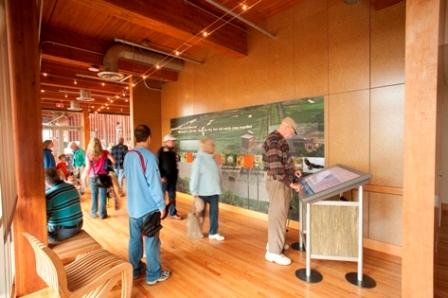The DuPont Environmental Education Center

Project Background
The DuPont Environmental Education Center (DEEC) at the Russell W. Peterson Urban Wildlife Refuge on Wilmington's Riverfront opened to the public in October of 2009. This four-story 13,500-square-foot multi-use education facility is owned by the Riverfront Development Corporation of Delaware and is operated by the Delaware Nature Society. It is located on the edge of the 212-acre Peterson Refuge on the tidal Christina River, where the city, river and marsh meet.
The Education Center showcases the many species of amphibians, birds, mammals, fish, reptiles and native plants that make their home in the refuge. Visitors are able to explore the interactive exhibits, join a guided tour, or participate in a variety of free and low-cost programs for students, youth groups, adults, families and teachers.
The Riverfront Development Corporation of Delaware (RDC), the non-profit organization charged with creating economic vitality along Wilmington’s Christina River worked with the Department of Natural Resources and Environmental Control (DNREC) and owners of the marsh properties to gain rights to establish the Russell W. Peterson Urban Wildlife Refuge on the Old Wilmington Marsh site.
The creation of DEEC and the extensive marsh restoration initiative is an important component of the ongoing redevelopment of the Christina River waterfront— a site of nearly $300 million worth of new corporate, retail, recreational and infrastructure investment. DEEC connects the city with a diverse and living wetland— home to many varieties of fish, amphibians, reptiles and birds.
The main project purpose was to provide a novel, restorative and dramatic destination for school groups, nature lovers and the community at large to experience wildlife and be “wowed” by nature within an urban landscape.
Back to topAbout the Facility
DEEC is located along Wilmington’s Riverwalk, a pedestrian walkway linking the center of the City to the waterfront and into the marsh. The facility features a visitor center, education programs and elevated observation walkways. The classrooms, workshops, offices and observation deck are a resource for school and community groups, as well as the millions of people who visit Wilmington’s riverfront each year.
The observation decks provide visitors with opportunities for interactive study, hands-on education and unobstructed visual access to the Russell W. Peterson Urban Wildlife Refuge. Visitors have an opportunity to explore the marsh along the boardwalk loop that links the Center to the heart of the Refuge. The boardwalk includes overlooks and education stations that allow visitors to experience and learn about the natural environment including the site’s native species of plant, fishes, amphibian, reptile and birds with minimal impact on the tidal wetlands.
The Delaware Nature Society manages and operates educational programming for the Center. The mission of the Delaware Nature Society (DNS) is to foster understanding, appreciation and enjoyment of the natural world, preserve ecologically significant areas and advocate stewardship and conservation of natural resources. Unlike many nature centers that offer environmental education only, DNS has Natural Resources Conservation and Advocacy components also. In addition, it is the Delaware affiliate of the National Wildlife Federation (NWF), with input on national issues of concern in our region.
Back to topDEEC’s Primary Objectives
- To provide educational orientation and motivational encouragement for visitors to explore the Russell W. Peterson Urban Wildlife Refuge environment
- To explore the natural and cultural heritage of the area
- To advocate for social and environmental justice and economic equity
- To develop interpretive opportunities that are participatory, adaptable, flexible, expandable and innovative
- To create points of engagement that can evolve with the present and future needs of the facility (stationary, mobile, seasonal and remote media exhibits)
Interpret Green’s Approach & Exhibition Design Goals
A key challenge to Interpret Green was to design a visitor-centric environment that cultivates curiosity, inspires interaction, enhances personal meaning, and encourages learning and deeper questioning. Other goals were to:
- Create an exhibition framework to contextualize themes and content for the visitor
- Design exhibit areas that emphasize and balance various experience realms including opportunities that are immersive, participatory, contemplative and absorptive
- Vary activity types to include observation, examination, exploration, investigation, manipulation, creation and construction
- Develop ways to improve the interior and exterior environment through creative and innovative design approaches, material and construction choices
- Create elements and experiences that are adaptable and capable of evolving over time in response to the changing needs of the facility and target visitors
Interpret Green also designed the website for The DuPont Environmental Education Center. Visit the website at www.duponteec.org.
Back to top